Northern Spring Begins While the Waxing Evening Moon Somewhat Spoils Comet Views!
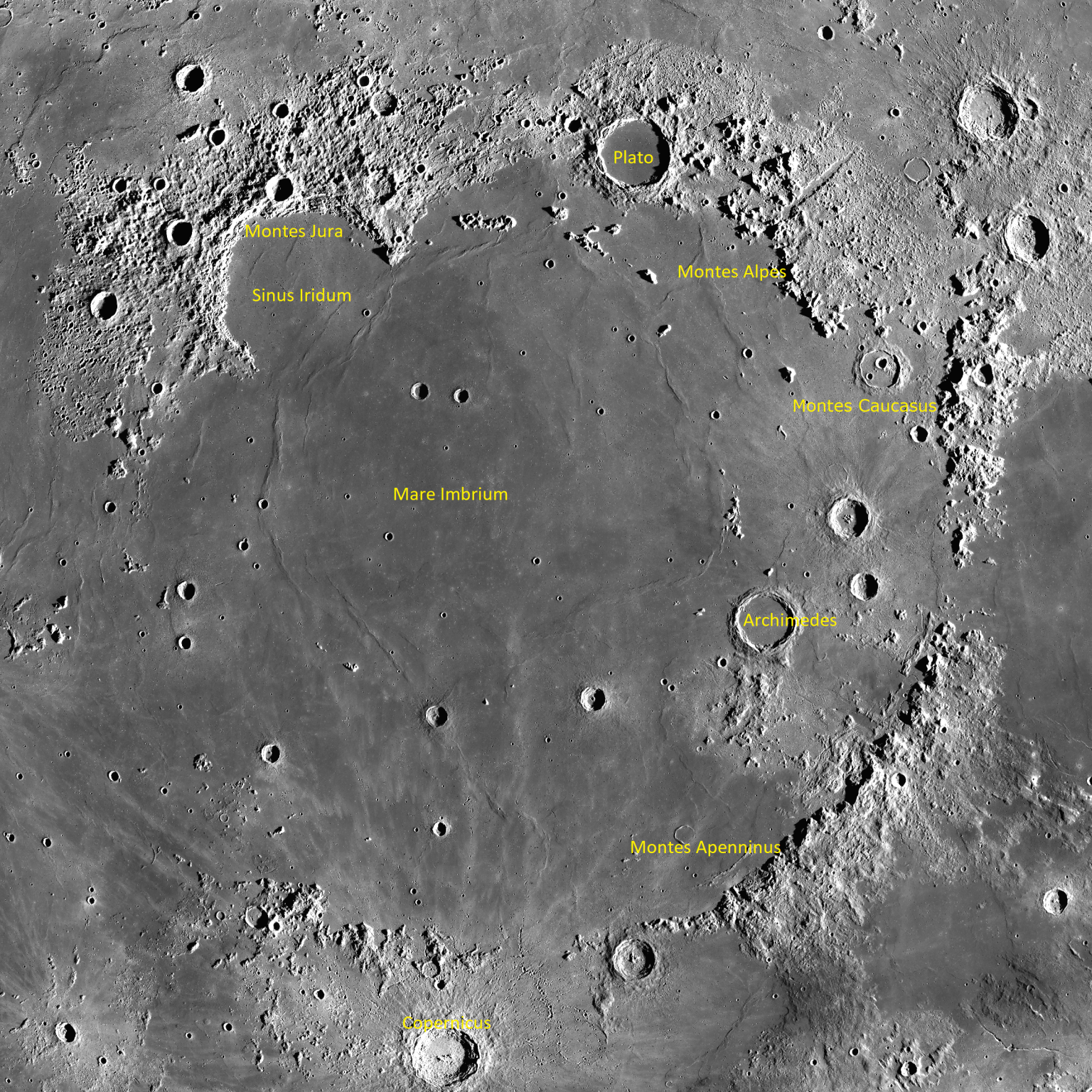
This Lunar Reconnaissance Orbiter image shows the major features of Mare Imbrium “he Sea of Rains”, including its eastern ring of mountain ranges,dark crater Plato, the “islands” in the north, Archimedes, and the subtle wrinkles. Other lunar maria are out of frame below the large crater Copernicus (botton centre). NASA
Hello, Spring Stargazers!
Here are your Astronomy Skylights for the week of March 17th, 2024 by Chris Vaughan. Feel free to pass this along to your friends and send me your comments, questions, and suggested topics. You can also follow me on Twitter as @astrogeoguy! Unless otherwise noted, all times are expressed in Eastern Time. To subscribe to these emails please click this MailChimp link.
If you’d like me to bring my Digital Starlab portable inflatable planetarium to your school or other daytime or evening event, or deliver a session online, contact me through AstroGeo.ca, and we’ll tour the Universe, or the Earth’s interior, together! My book with John A. Read entitled 110 Things to See With a Telescope is a guide to viewing the deep sky objects in the Messier List – for both beginners and seasoned astronomers. DM me to order a signed copy!
Spring in the Northern Hemisphere will arrive on Tuesday. The moon will brighten each evening as it waxes in phase, and offer some terrific sights to see on it. The moonlight will hamper our views of Comet 12P/Pons-Brooks, which is in the west after sunset near Jupiter. Venus will appear low in the pre-dawn east, where it will kiss far fainter Saturn while Mars looks on. Read on for your Skylights!
Happy March Equinox!
On Tuesday, March 19 at 11:06 pm EDT, 8:06 pm PDT (and 03:06 Greenwich Mean Time in other parts of the world), spring will officially arrive in the Northern Hemisphere! At that moment, the sun’s apparent motion eastward along the ecliptic will carry it cross the celestial equator and into the northern sky. (Of course, the sun isn’t moving – Earth is!) The astronomical term for this event is the Vernal Equinox, where “vernal” is Latin for “spring”. I prefer to say March Equinox because autumn will commence for everyone in the Southern Hemisphere on that same day. The hemispheres will trade autumn for spring again at the September or Autumnal Equinox.

On each of the two equinoxes, the world experiences about 12 hours each of daylight and darkness. This is where the word equinox (Latin for “equal night”) comes from. The actual date containing 12 hours of day and night, known as the equilux, varies according to latitude. In the zone encompassing southern Canada and the northern USA states, that occurs today – on March 17 in 2024. The day-night balance varies by latitude and doesn’t quite hold true at the poles where you could climb a ladder and see the sun. Moreover, the amount of daylight is always a few minutes longer than night because the disk of the sun takes 2 minutes to rise or set at the equator and even longer at higher latitudes where the ecliptic is tilted. In other words we’ve already started to see the sun when its centre crosses the horizon rising, and we still see the upper half of the sun for a while after its centre sets.
The March Equinox produces several interesting effects. For the following six months, the sun will spend more than 50% of each 24-hour period shining overhead of the lucky folks in North America, Europe, and Asia! More time with the sun above the horizon means warmer air and longer daylight hours! At the same time, folks in the Southern hemisphere have to accept shorter, colder days and longer nights. (Warmly dressed astronomers don’t mind long winter nights!)
The amount of daylight increases fastest around the equinox. With the sun setting about 1.2 minutes later every night and rising about 1.8 minutes earlier every morning, each subsequent day brings three more minutes of daylight. Conversely, the amount of daylight decreases by about three minutes per day around September 20. The day/night balance changes extremely slowly around the winter and summer solstices in later December and June, respectively.
The period around the equinoxes also offer increased odds of seeing the aurorae at both high northern and southern latitudes. Just as two bar magnets lined up with their poles in the same direction repel one another strongly, the Earth’s magnetic field repels the sun’s field. At the equinoxes, the Earth’s axial tilt is orthogonal to the Earth-sun line, so the two “magnets” aren’t as parallel, reducing Earth’s ability to repel the sun’s field and the charged particles that trigger aurorae in our upper atmosphere.
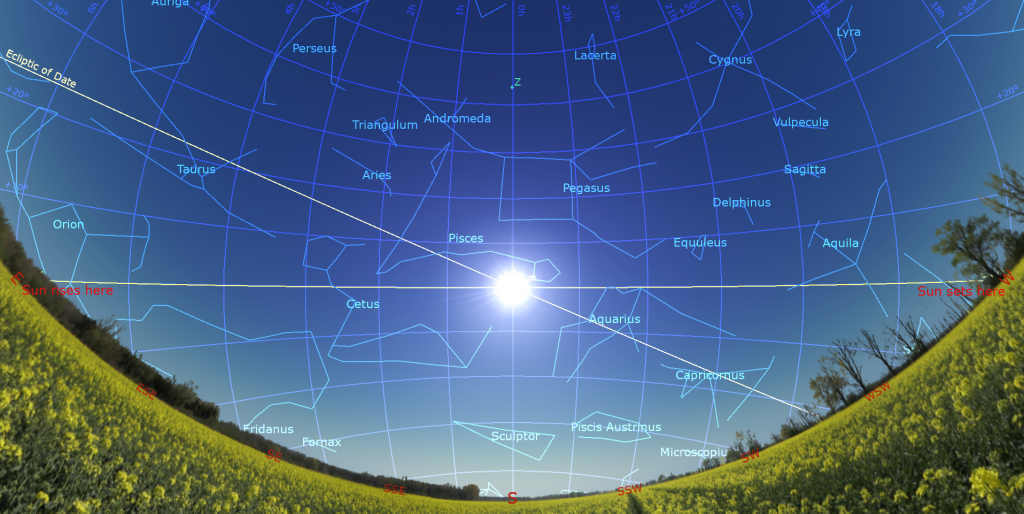
It seems highly likely that St. Patrick’s Day, now observed annually on March 17, arose after the early Christian Catholic church converted pre-existing Celtic celebrations already being observed at the equinox to a church feast day. It drifted away from the typical equinox date because of inaccuracies in the Julian calendar.
Persians will celebrate their New Year, called Nowruz or Norooz “New Day” on Tuesday, March 19, 2024. It begins at the midnight hour occurring closest to the March equinox, as measured in Iran Standard time. In 2024, spring in Iran begins on March 20 at 6:36 am. The Persian calendar, which originated with the Babylonians, is based on the sun, but not the moon. I discussed this and other connections between world religions and astronomy during an Insider’s Guide to the Galaxy session on YouTube here.
The Moon
The moon will dominate the evening and overnight sky worldwide this week as it waxes in phase. The moon completed the first quarter of its orbit around Earth, measuring from the previous new moon, this morning (Sunday) at 12:11 am EDT or 04:11 GMT – so it appeared half-illuminated last night. For the rest of the week the moon will exhibit a gibbous phase as its angle from the sun increases.
This is the best time of the lunar month to view our natural satellite through binoculars and telescopes because we are watching the sun slowly rise over its Earth-facing hemisphere. The terrain on the sunward side of the pole-to-pole terminator is being lit by nearly horizontal rays of light – producing long shadows to the west of every elevated bump, mountain peak, and crater rim. The terminator continuously creeps west, allowing us to watch for tall peaks catching the sun before the terminator reaches them, and for deep craters on the sunny side of the border to still have dark floors. Check back frequently! As a bonus, the moon rises in the middle of the day, so it’s available for a peak then. Junior astronomers can enjoy its sights before bedtime.
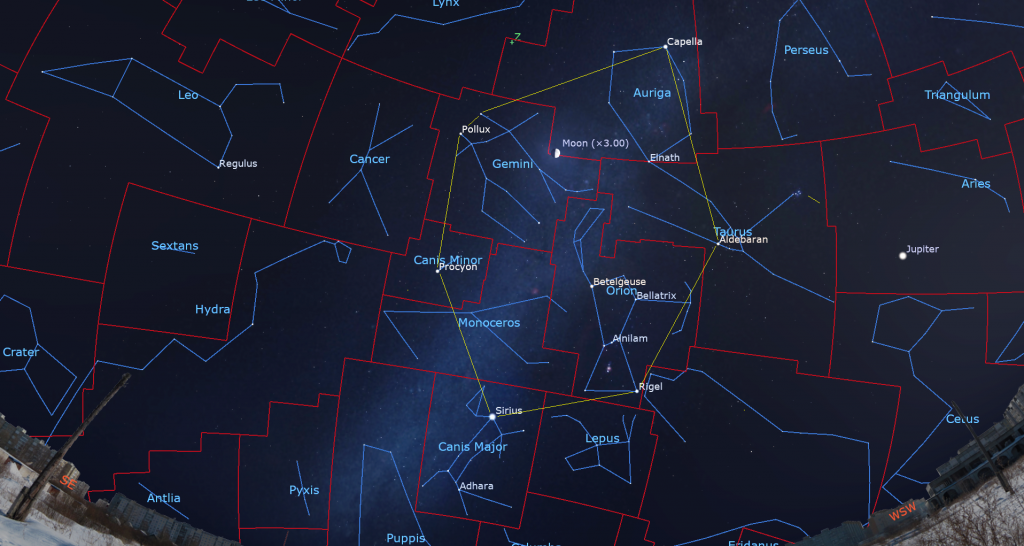
Tonight the 59%-lit moon will shine inside the Winter Hexagon, a huge ring formed by connecting the brightest stars of the winter constellations (yes – there are still around for a few weeks longer). The bright yellowish star Capella will appear to the moon’s right. Gemini’s twins Pollux (on the left) and Castor (on the right) will sparkle to the moon’s upper left. Counter-clockwise from Gemini, the rest of the ring is composed of Procyon, Sirius, Rigel, and orange Aldebaran in Taurus (the Bull). Reddish Betelgeuse sits in the middle.
The moon will spend Monday night in the ring near Pollux, and then it will slide east into Cancer (the Crab) for Tuesday and Wednesday. If you hide the bright moon just beyond the upper right edge of your binoculars’ field of view on Tuesday, you might spot the scattered clump of stars known as the Beehive Cluster (and Messier 44) to the moon’s lower left (or celestial SSE).

Also on Monday night, the terminator will pass north-south through the large and circular Imbrium Basin, which dominates the moon’s northern half. Use any size of telescope to look for sinuous wrinkle ridges slithering over the seemingly flat floor of that large mare. A dark, very round, and smooth crater named Plato will interrupt the Alpine Mountains that curve along the northern edge of the basin. A curving chain of little mountain peaks will poke out of Imbrium’s gray floor below Plato. Those include Montes Recti, Montes Teneriffe, and the single peaks of Mons Pico and Mons Piton.
At the southern edge of Imbrium’s big circle, the Apennine Mountain range sinks almost out of sight after it passes the small peaked crater Eratosthenes. The big crater Copernicus sits between Imbrium and the basins farther south. Watch for a broad blanket of rubble spread around Copernicus’ exterior. The mountainous area sitting just above Copernicus are the Montes Carpatus – a continuation of Imbrium’s ringed perimeter. Farther south, smaller Mare Cognitum the “Sea of Knowledge” and Mare Nubium the “Sea of Clouds” will be obvious. Nubium has been marred by a number of craters, the largest of which is Bullialdus. Finally, down near the moon’s southern pole, you’ll find my favorite crater Clavius. Binoculars or a backyard telescope will reveal a curved chain of craters, each descending in diameter, inside it.

The curved bay of Sinus Iridum “the Bay of Rainbows”, which straddles the northwestern edge of Mare Imbrium, will be alongside the terminator on Wednesday night. That semi-circular, 249 km diameter feature is a large impact crater that was later flooded by the same basalts that filled Mare Imbrium – forming a rounded bay on the western edge of the mare. The prominent Montes Jura mountain range surrounds Sinus Iridum on the north and west – the original crater rim. Sinus Iridum is almost craterless, but hosts its own set of northeast-oriented wrinkle ridges. In a backyard telescope you can see where the mountains submerge below the basalts, forming the lunar promontories named Laplace (the northern tip) and Heraclides (the southern tip).
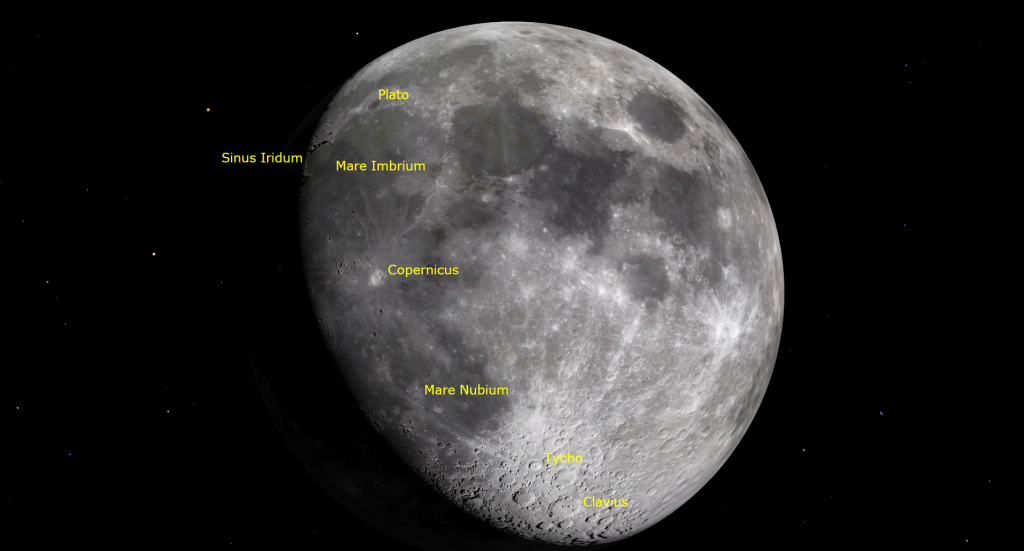
On Thursday night, all of Mare Imbrium will be in view while the moon gleams above Leo’s brightest star Regulus. Imbrium’s western and southern edges bleed into the vast, grey realm of Oceanus Procellarum “the Sea of Storms”. Tucked alongside the southern part of the terminator, watch for the well-defined dark oval of Mare Humorum “the Sea of Moisture”. The large, peaked crater Gassendi will occupy its upper left (northern) edge is. Gassendi’s complex floor is a fascinating sight in a telescope. Almost at the moon’s southern pole you’ll see the oddly elongated scar of the crater Schiller.
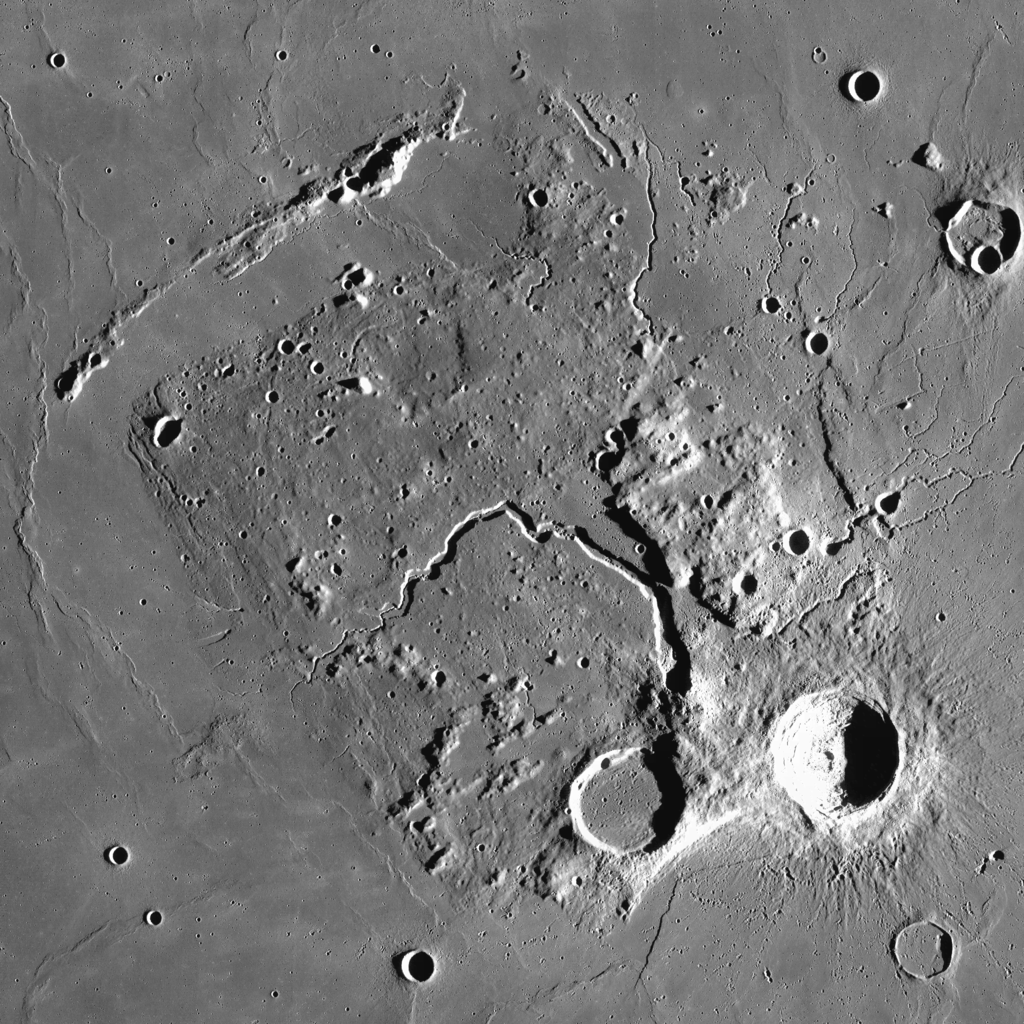
The moon will continue sliding below the main stars of Leo (the Lion) on Friday and Saturday. On Friday night, more of the Sea of Storms will appear, revealing the amazing Aristarchus Plateau. In the lower left portion of the moon, look for a small, but very bright crater Aristarchus at the southeastern corner of a diamond-shaped plateau that is one of the most colorful regions on the moon. NASA orbiters have detected high levels of radioactive radon there. Use a telescope and high magnification to view features like the large, sinuous rille named Vallis Schröteri. Its snake-like form begins between Aristarchus and the next-door crater Herodotus and slithers across the plateau.
With 90% of the moon illuminated from Thursday onward, the lunar ray systems around the younger craters will become very obvious. The extensive, ragged ray system of Copernicus will intermingle with the rays of the smaller crater Kepler to its lower left (southwest). Over on the right half of the moon, Tycho’s brilliant rays will radiate as sharp, bright lines that stretch up to 1,500 km from the crater.
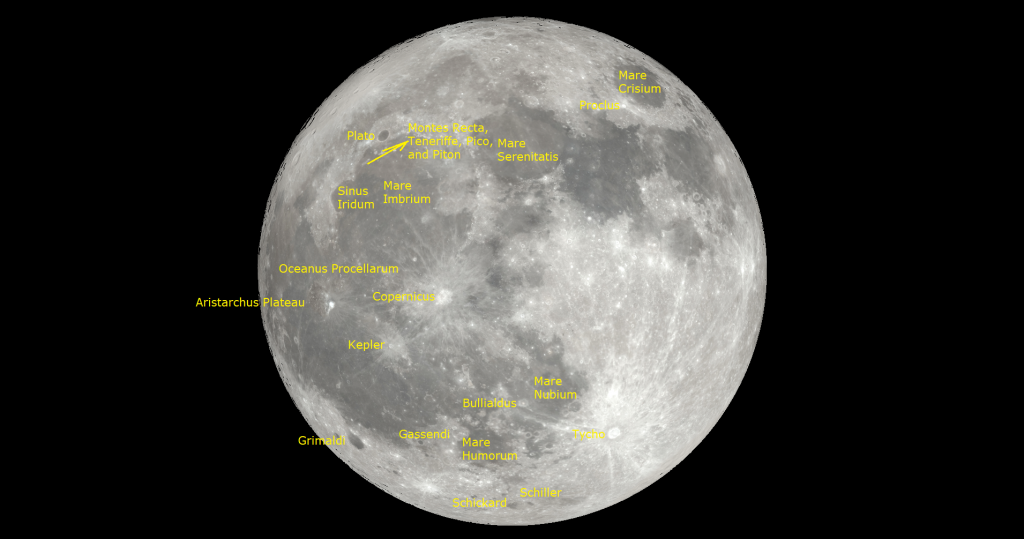
On next Sunday night, the moon will be hours away from officially being full. All of Oceanus Procellarum will be illuminated, and the various rays will be visible all over the place! Watch for the dark oval of Grimaldi, a basalt-flooded crater, near the moon’s lower right edge. When the moon is this full, nothing casts a shadow – all of the variations of grey are produced by variation in rocks type. Return to the various maria and look for darker zones. Some of those are dark basalt that leaked in early and were later not quite fully overlain by lighter lava. Other darker patches are volcanic ash deposits from long-dead volcanoes.
There’s a very nice moon map here.
Comet Pons-Brooks
I’ve been updating everyone about a periodic comet named 12P/Pons-Brooks that is visible in the northwestern sky in early evening. The comet has so-far reached about magnitude 5.5, which is within reach of any telescope and good binoculars under dark skies. Unfortunately, this week’s brightening moon will increasingly hamper our comet views – but the comet will stick around until we get darker skies next week. It should even grow a bit brighter as it draws closer to the sun and warms further.
For observers in mid-northern latitudes on Earth, the comet will be descending the western sky after dusk every night. The best combination of sky darkness and the comet’s height will be around 9 pm in your local time zone. Visually, expect to see a faint, fuzzy smudge that may look greenish in larger telescopes. Its faint tail, best seen in binoculars and long exposure photos, will extend upwards to the right, towards the large Andromeda Galaxy nearby. The comet will drop below the rooftops by about 10 pm, so look earlier than later.
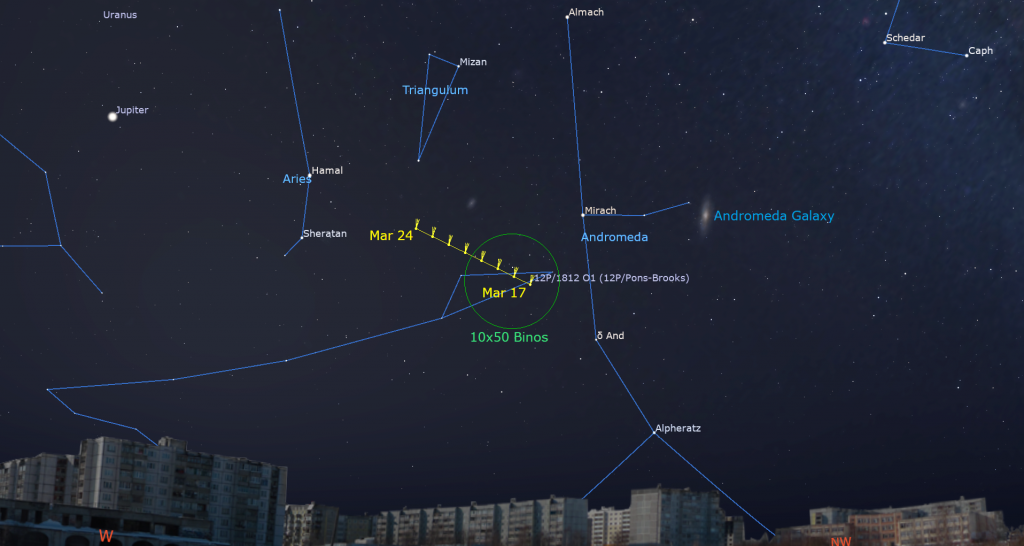
I’ve seen the comet on three nights in the past week, once from my light-polluted driveway. This week, it will travel in the direction of Jupiter – from lower right-to-upper left in the sky below and between the bright stars Mirach and Hamal. Hamal is the bright star shining a generous fist’s diameter to Jupiter’s lower right. Start on Hamal and sweep you binoculars down and away from Jupiter. If you reach the medium-bright star Delta Andromedae, you’ve gone too far. Let me know if you see it!
The Planets
We will continue to have three planets available for viewing after sunset this week. Mercury will climb higher in the western, post-sunset sky each night. Its medium-bright speck can be teased out of the surrounding twilight, but wait until the sun has fully set before searching with binoculars. Mercury’s rapid ascent above a nearly vertical evening ecliptic will produce the best evening appearance of the planet in 2024 for Northern Hemisphere observers, but a very poor one for those in the Southern Hemisphere. The planet will be waning in illuminated phase and diminishing in brightness all month long. Mercury will reach peak visibility next Sunday, when it will show a gibbous, football shape in telescopes, shine at magnitude -1.0, and set about 80 minutes after the sun.
While you are looking for Mercury after sunset, much brighter Jupiter will be visible about halfway up the western sky. Jupiter will show well in any telescope, especially if you view the giant planet early-on, while it’s higher in the sky. The reasonably good views of Jupiter will last until about 9:30 pm local time. Then the planet will set in the west around 11:15 pm. In a dark sky, the stars of Aries (the Ram) will appear to Jupiter’s right and the bright stars of the winter constellations will sparkle off to the upper left (or celestial southeast).
Any decent pair of binoculars can show you Jupiter’s four largest Galilean moons lined up on both sides of the planet. Named Io, Europa, Ganymede, and Callisto in order of their orbital distance from Jupiter, those moons complete orbits of the planet every 1.7, 3.6, 7.2, and 16.7 days, respectively. If you see fewer than four moons, then one or more of them is crossing in front of or behind Jupiter, or hiding in Jupiter’s dark shadow – or two of the moons are very close together or occulting one another. All four moons will huddle to one side of Jupiter on Monday and next Sunday evening.
A small telescope will reveal Jupiter’s dark belts and light zones, which are aligned parallel to its equator. With Jupiter is descending in the west these days, its stripes are tilted upright. With a better grade of optics, Jupiter’s Great Red Spot, a cyclonic storm that has raged for hundreds of years, is visible for several hours when it crosses the planet every 2nd or 3rd night. GRS appearances are fewer when the planet is only visible for a few hours each night. For observers in the Americas, the GRS will cross Jupiter’s disk in mid-evening Eastern Time on Thursday and Saturday. The spot has been rather a pale pink in colour for some time now. If you have any coloured filters or nebula filters for your telescope, try enhancing the spot with them.
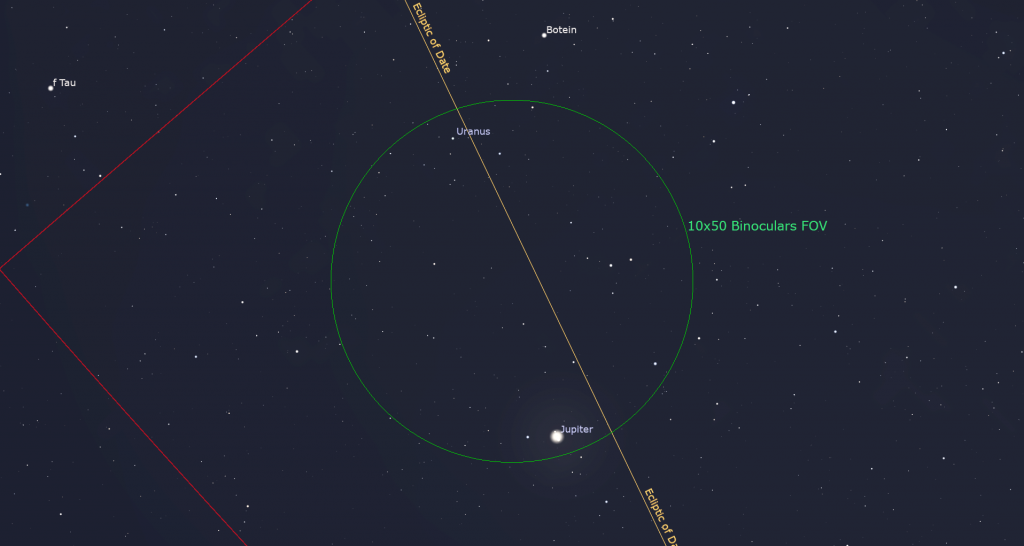
Uranus‘ blue-green speck is trailing about 30 minutes behind Jupiter on the ecliptic, so it will be visible until about 10 pm. The magnitude 5.8 planet is quite easy to see in binoculars and backyard telescopes, but not so much when the moon is bright. Look for Uranus just less than a palm’s width to Jupiter’s upper left (or 5.2° to its celestial east). That is close enough for them to share the view in binoculars – with Uranus at the top and Jupiter at the bottom. Uranus will also be positioned about two finger widths to the lower left of a medium-bright star named Botein (or δ Arietis). The bright Pleiades star cluster will sparkle a bit more than a fist’s width above Uranus (or 11° to its celestial northeast). Since Jupiter is closer to the sun than Uranus, its faster motion will carry it steadily closer to Uranus every night until they kiss in twilight on April 20.
Mars, Venus, and Saturn will all rise in the east shortly before the sun – but the severely tilted morning ecliptic will keep them low in a brightening sky, making the two fainter planets hard to see. Observers living closer to the tropics, where the ecliptic will stand upright, will have a much easier view.
Venus is swinging closer to the sun every morning, causing the brilliant planet to shift down and to the left compared to any nearly trees or buildings near it. Meanwhile, Mars and Saturn will be increasing their angle from the morning sun, eventually allowing them rise with the stars this spring.
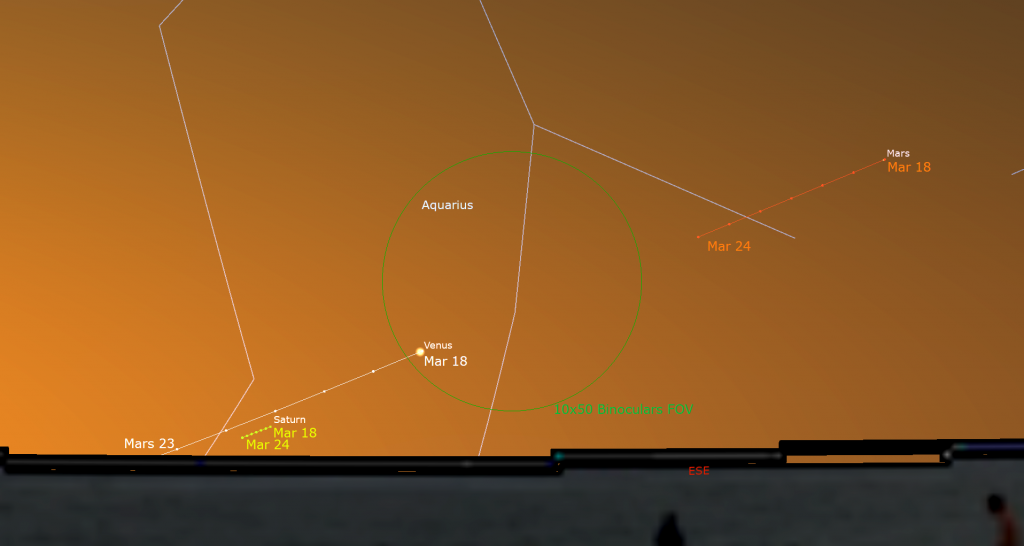
The opposite trajectories of Venus and Saturn will allow folks located in the southern USA and other tropical latitudes to see Venus kiss Saturn in a very close dawn planetary conjunction on Thursday morning, March 21. The two planets will be close enough to share the view in a backyard telescope on Thursday and Friday, and in binoculars for about five days on either side of that date – but the views of them will be hampered by the thick blanket of air they will be shining through. Be sure to turn all optics away from the horizon before sunrise. On Thursday, Saturn will be positioned less than a finger’s width below (or 0.7 degrees to the celestial east of) Venus. On Friday, it will shift to Venus’ right. For the latitude of Miami, the optimal viewing time will arrive around 7 am local time. Venus will meet the sun at solar conjunction in early June.
Not-too-bright Mars, which shifts from Capricornus (the Sea-Goat) to Aquarius (the Water-Bearer) on Wednesday, will shine to the upper right of Venus and Saturn every morning. At mid-northern latitudes Mars will rise at about 6:15 am local time, but you may need to walk around to position the planets between trees or buildings.
Pointing at Polaris
If you missed last week’s information about Polaris, commonly known as the North Star, I posted it here.
Public Astronomy-Themed Events
Every Monday evening, York University’s Allan I. Carswell Observatory runs an online star party – broadcasting views from four telescopes/cameras, answering viewer questions, and taking requests! Details are here. They host in-person viewing on the first clear Wednesday night each month. Other Wednesdays they stream views online via the observatory YouTube channel. Details are here.
At 7:30 pm on Wednesday, March 20, the RASC Toronto Centre will livestream their free monthly Speaker’s Night Meeting. The speaker will be Marianna Veltri, York University, Honours Physics and Astronomy. Her topic will be Galactic Powerhouses: Exploring Quasars and Their Spectacular Spectra. Check here for details and watch the presentation at https://www.youtube.com/rasctoronto/live.
On Thursday, March 21, starting at 8 pm, U of T’s AstroTour will present a free public presentation about the April 8 2024 Solar Eclipse. The speaker will be Charles J. Woodford, the Education Coordinator for Discover the Universe. The talk will be followed by astronomy demos and telescope tours (weather permitting). Details are here.
On Saturday, March 23 from 8 to 10 pm EST, the in-person Astronomy Speakers Night program at the David Dunlap Observatory in Richmond Hill, Ontario will focus on lunar eclipses.After the presentation, participants will tour the observatory and see a demonstration of the 74” telescope pointed to an interesting celestial object for the visitors to view (weather permitting). More information is here and the registration link is at ActiveRH.
Keep your eyes on the skies! I love getting questions and requests. Send me some!